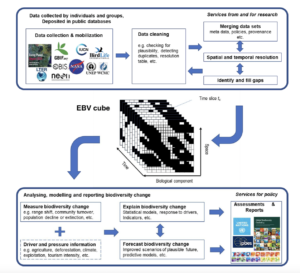Essential variables to understand climate, biodiversity, and other environmental changes have already been developed (e.g. Essential Climate Variables, Essential Ocean Variables). The concept of Essential Biodiversity Variables (EBVs) was introduced to advance the collection, sharing, and use of biodiversity information (Pereira et al. 2013; Navarro et al. 2017), providing a way to aggregate the many biodiversity observations collected through different methods such as in situ monitoring or remote sensing. EBVs can be visualised as biodiversity observations at one location over time, or in many locations, aggregated in a time series of maps.
The process towards operationalising EBVs is shown in the accompanying figure. Filling the EBV cube requires collecting biodiversity observations by people and groups, depositing raw data into databases using standard formats and metadata, and processing the data (upper box). The information in the EBV cube helps to detect and model biodiversity change for science, policy, and sustainable development applications (lower box). The underlying drivers and pressures of biodiversity change can then be identified (Mace and Baillie 2007) and modelled (Oliver et al. 2015). Validation of modelling can then feed into global and regional policy processes to explain observations, to improve forecasting of biodiversity change, and to produce global assessment reports.
EBVs are scalable, meaning the underlying observations can be used to represent different spatial or temporal resolutions required for the analysis of trends. For example, ecological community data collected at a location from different sampling events or methods can be combined into a single time series. The aggregated data may indicate the change in ecological communities across the region.
When combined with social or economic information from human or environmental pressures, EBVs can be used to identify indicators for biodiversity that reflect responses, for example change in the proportion of habitat in PAs and ecosystem service benefits to humans.
Developing and applying EBVs requires local, national, and international adoption of standard approaches to collect, store, and share biodiversity and environmental observations. This is fundamental to address the pressing societal and economic needs of today and in the future.

EBV classes and names
There are 6 EBV classes and 21 EBV names. By clicking on the icon you will get more detailed information.
References
Balvanera, P., Brauman, K.A., Cord, A.F., Drakou, E.G., Geijzendorffer, I.R., Karp, D.S., et al. (2022). Essential ecosystem service variables for monitoring progress towards sustainability. Curr. Opin. Environ. Sustain., 54, 101152.
Mace, G.M. & Baillie, J.E.M. (2007). The 2010 biodiversity indicators: challenges for science and policy. Conserv. Biol., 21, 1406–1413.
Navarro, L.M., Fernández, N., Guerra, C., Guralnick, R., Kissling, W.D., Londoño, M.C., et al. (2017). Monitoring biodiversity change through effective global coordination. Curr. Opin. Environ. Sustain., 29, 158–169.
Oliver, T.H., Heard, M.S., Isaac, N.J.B., Roy, D.B., Procter, D., Eigenbrod, F., et al. (2015). Biodiversity and resilience of ecosystem functions. Trends Ecol. Evol., 30, 673–684.
Pereira, H.M., Ferrier, S., Walters, M., Geller, G.N., Jongman, R.H.G., Scholes, R.J., et al. (2013). Essential biodiversity variables. Science, 339, 277–278.
Schmeller, D.S., Mihoub, J.-B., Bowser, A., Arvanitidis, C., Costello, M.J., Fernandez, M., et al. (2017). An operational definition of essential biodiversity variables. Biodivers Conserv, 26, 2967–2972.

